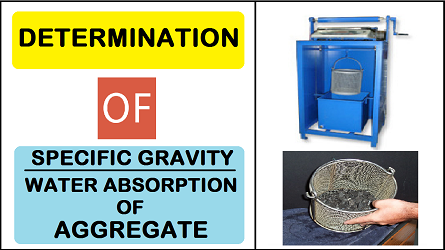Hello Friends, This is Mukesh from Learning Technology. I will tell you in today’s post, Determination of Specific Gravity & Water Absorption of Aggregate in a very easy way.
Contents
Objective of Experiment
Determination of specific gravity and water absorption of aggregate having the size between 10 mm to 40 mm.
Performance objectives
a) To determine the specific gravity, an apparent specific gravity of the aggregate.
b) To determine water absorption of the aggregate.
c) List the limits in which specific gravity falls.
d) To set up the experiment.
e) To follow the procedural steps with precautions.
f) To fill up the observation table correctly.
g) To report as per instruction
Theory
The specific gravity of an aggregate is defined as the ratio of the mass of the solid of a given volume of sample to the mass of an equal volume of gas-free distilled water, both taken at the standard temperature i.e. 27-degree celsius. Since the aggregate generally contains voids, there are different types of specific gravities. The absolute specific gravity refers to the volume of solid material excluding all pores, and therefore, is defined as the ratio of the mass of solids to the weight of an equal gas-free volume of water at a stated temperature. Generally, it is not required for civil engineering construction work. If the volume of the solid is deemed to include the impermeable pores, but not the capillary ones, the resulting specific gravity is called ‘Apparent specific gravity’.
The Apparent specific gravity is then the ratio of the mass of the aggregate dried in an oven at 100 degrees Celsius to 110 degrees Celsius for 24 hours to the mass of water occupying a volume equal to that of the solid including the impermeable pores. The specific gravity most frequently required and easily determined, known as ‘gross apparent specific gravity’, is based on the saturated and surface-dry condition of the aggregate because the water absorbed in the pores of the aggregate does not take part in the chemical reaction of the cement and can, therefore, be considered as a part of the aggregate. This specific gravity is required for the calculation of the yield of concrete or of the quantity of aggregate required for a given volume of concrete. It is seen that the higher the specific gravity of an aggregate, the harder and stronger it is likely to be. If the specific gravity is above or below that normally assigned to a particular type of aggregate, it may indicate that the shape and grading of the aggregate have changed.
The apparent average specific gravity of different rock groups are:
Basalt: 2.80, Granite: 2.7, Lime Stone: 2.66 with a wide range of variation. The Apparent specific gravity of majority of natural aggregate lies between 2.6 and 2.7
If the aggregate is dry, it absorbs water, which takes part neither in chemical reaction nor in the lubrication of particles. Thus, if the phenomenon of absorption is ignored in totally dry aggregates, both workability and effective water-cement ratio are reduced. Absorption of air-dried aggregates is, however, less than bone-dry aggregates. The absorption and porosity affect the bond between the aggregate and the cement paste, the resistance of concrete to freezing and thawing, stability and resistance to abrasion. The water absorption is determined by measuring the decrease in mass of a saturated and surface-dry sample after oven drying for 24 hours. The percentage of water absorbed by an aggregate when immersed in water is termed as absorption of aggregate.
ALSO READ
- Determination of Specific Gravity of Sand
- Determination of Fineness of Cement by Sieving
- Determination of Initial and Final Setting Time of Cement
- Compressive Strength Test of Cement
- Fineness Modulus of a Sample of Fine Aggregate
- Determination of Normal Consistency of Cement
- Specific Gravity Test for Bitumen
- Bitumen Penetration Test – Consistency Test
- Softening Point of Bituminous Materials
- Aggregate Abrasion Value Test
Equipment required
As per IS 2386 (Part III) – 1963, the apparatus to be used are as follows:
1. Balance – A balance or scale of capacity not less than 3 kg, readable and accurate to 0.5 gram and of such type as to permit the weighing the vessel containing the aggregate and water.
2. Oven – A well ventilated, thermostatically controlled oven in order to maintain the temperature of 100 degrees Celsius to 110 degrees Celsius.
3. Glass vessel – A wide-mouth glass vessel of about 1.5 liters capacity, with a flat ground lip and a plane ground disc of plate glass to cover it, giving a virtual watertight fit.
4. Cloth – Two dry soft absorbent cloths, each not less than 75 x 45 cm.
5. Tray – A shallow tray of an area not less than 325 cm square.
6. Container – An airtight container large enough to take the sample.
Procedure
Take about 500 grams of aggregate or weight the amount of aggregate for a sample as instructed by the teacher. Aggregate, which has been artificially heated, shall not normally be used; if such aggregate is used then it should be mentioned in the report.
1. The sample is washed to remove the particles of dust after screening the sample through 10 mm IS sieve.
2. The sample is placed in the vessel and immersed in distilled water for 24 hours at a temperature of 22 degrees Celsius to 32 degrees Celsius.
3. At the end of the soaking period remove the air bubbles on the surface of aggregate, which is achieved by rapid clockwise and anti-clockwise rotation of vessel between the operator’s hand.
4. The vessel is filled up to brim by adding distilled water and the ground glass disc is slide over the mouth so that no air is trapped in the vessel. Dry the vessel from outside and weight (A).
5. The vessel is emptied by draining of the aggregate. Again fill the vessel with distilled water. Slide the ground glass disc as before. The vessel is dried from outside and it is weighed (B).
6. The aggregate is placed on a dry cloth to get it surface-dried gently with hand then it is transferred to a second cloth when the first will remove no further moisture.
7. The aggregate is spread over a second cloth and exposed to the atmosphere (away from direct sunlight) not less than 10 minutes until it is fully dried and then weighted (C).
8. Then the aggregate is placed in the thermostatically controlled oven maintaining the temperature 100 degrees Celsius to 110 degrees Celsius for 24 hours. It is then cooled in the air-tight container and weighed (D).
9. Enter the reading correctly in the observation table and determine the specific gravity and water absorption
Observation table
| Description of Experiment | Sample I | Sample II |
| Weight of Vessel + Sample + Water (A) grams | ||
| Weight of Vessel + Water (B) grams | ||
| Weight of saturated & surface dry sample (C) grams | ||
| Weight of Oven-dried sample (D) grams | ||
| Apparent specific gravity = D / (B – (A – D)) | ||
| Gross Apparent specific gravity = C / (B – (A – C)) | ||
| Water Absorption = (C – D) x 100 / D |
Average Values
Apparent specific gravity = ………………..
Gross Apparent specific gravity = ………………
Water absorption = ……………….
ALSO READ
- Flash and Fire Points of Bituminous Materials
- Determination of Flakiness and Elongation Index of Coarse Aggregates
- Stripping Value of Road Aggregate by Dynamic Immersion Method
- Determination of Efficiency of a Centrifugal Pump
- Calibration of V-Notch Experiment
- Aggregate Impact Value Test as per IS 2386 (Part-IV) 1993
- Aggregate Crushing Value Test
- Water Content of Soil by Oven Drying Method
Precautions
1. Washing and screening of the sample should be done.
2. Proper care should be taken so that there is no air bubble in the glass vessel and aggregate surface before weighing (A).
3. The temperature of the oven should be properly maintained.
4. Record the observation correctly.
5. Weighing should be proper.
Conclusions
From the value of the specific gravity of a given aggregate, we can make an approximate idea about the quality and the properties of aggregate. It is also approximately used for judging the bulk density, by comparison with normal Specific gravity for that type of aggregate. Apparent specific gravity, gross Apparent specific gravity and water absorption, water content values are used.







What is freezing and thawing?